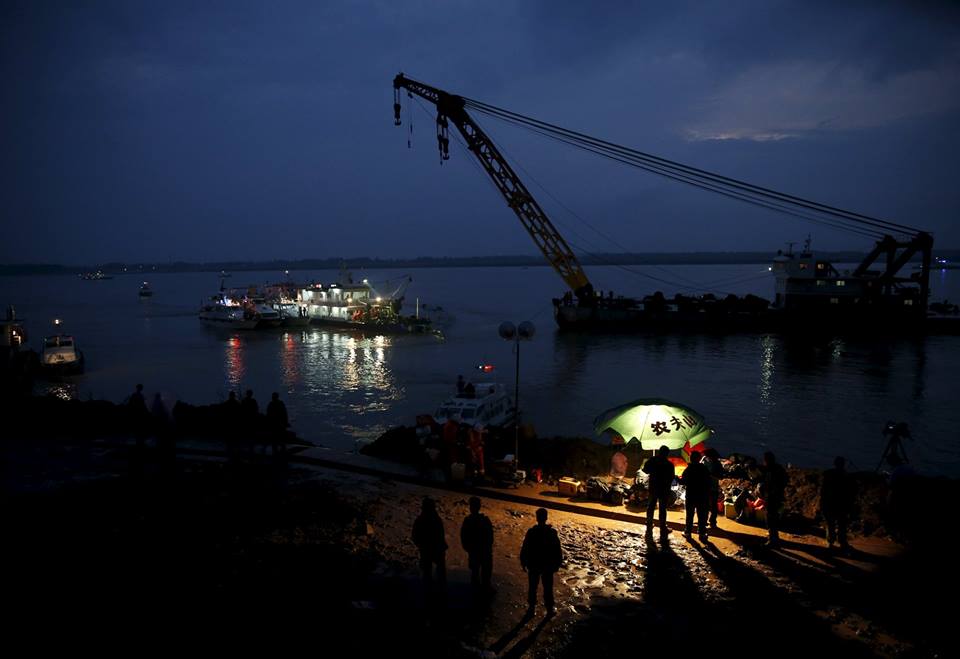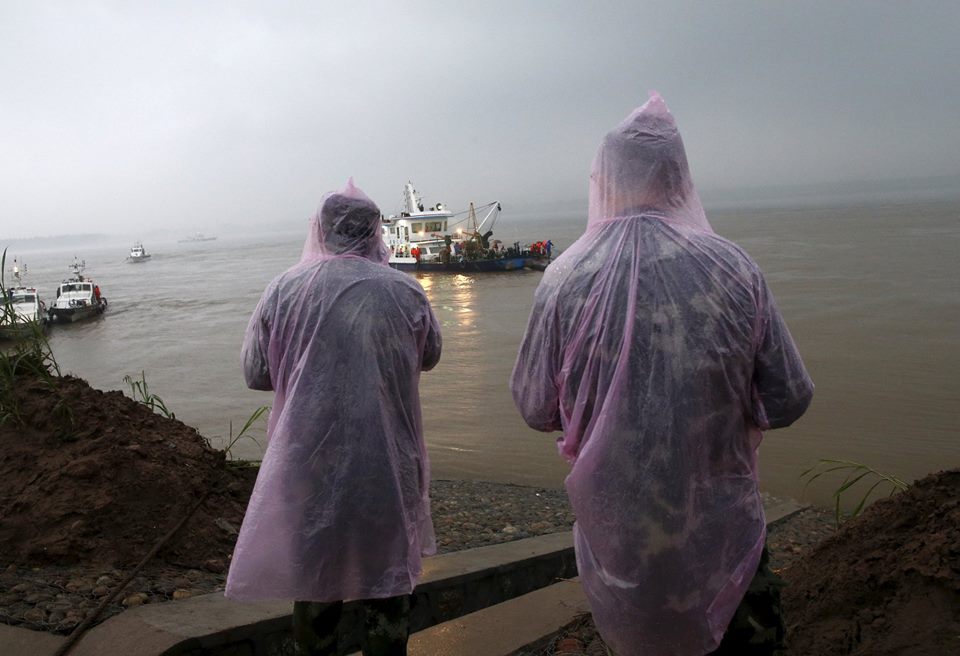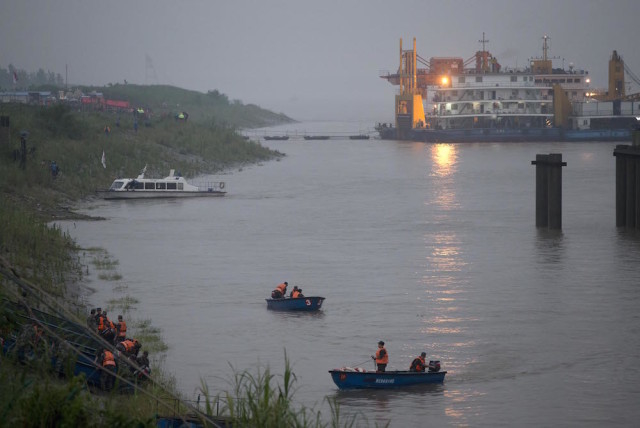Chinese Premier Li Keqiang called for an all-out effort to save lives following the sinking of a passenger ship with 456 people on board in the Hubei section of the Yangtze river Monday night.
Rescuers were braving bad weather in search of more survivors from the capsized Dongfangzhixing, or Eastern Star, cruise ship which sank around 9:28 p.m. So far 14 people have been rescued — two from the wreckage and 12 from the water. More than 430 are still missing, and seven have been confirmed dead.

Many passengers had retired to bed around 9 p.m. Monday when a storm began, said Zhang Hui, a tour guide from Shanghai who was rescued Tuesday.
[flagallery gid=141]
Twenty minutes later, the ship began to tilt. Zhang said when he was picking up fallen objects he was hit by an eerie feeling of foreboding. Then the ship capsized.
It all happened within a minute, he said.
Aerial photo shows the rescue scene in the Jianli section of the Yangtze River Tue. #Yangtzeshipsinks pic.twitter.com/IPQBxHa5WN
— People’s Daily,China (@PDChina) June 2, 2015
Meteorologists on Tuesday confirmed that a sudden, strong and violent storm did occur at the section of the Yangtze River where the cruise ship sank. The tornado-like wind, measuring more than 12 on the Beaufort scale, lasted about 15 to 20 minutes, and centered on the Yangtze River, according to experts with the China Meteorological Administration (CMA). Around 15:00 Tuesday, rescuers successfully saved a 21-year-old man named Chen Shuhan, an oiler on the ship who was trapped inside a 10-square-meter (about 107 square-foot) cabin that was just beginning to float to the surface ofthe water.

“The bottom of the ship had a layer of air cushion, which was 1.5 to 2 meters (5 to 6 and a half feet) thick. The victim was sitting on a water pipe in the upside down ship bottom,” he said, adding that divers also installed clevis hooks under the ship in preparation for a future salvage.


China’s Ministry of Transport said that over 180 divers are being deployed for the underwater search operations.
The sinking of the Eastern Star could be the worst of its kind in China for decades. At least five people were confirmed dead and hundreds remained missing as of 18:00 on Tuesday, according to the provincial government.
Photos show Premier Li giving on-site instructions on the rescue work in Jianli, Hubei #Yangtzeshipsinks pic.twitter.com/Mh0xhk23EV — People’s Daily,China (@PDChina) June 2, 2015
Li called for regular and transparent updates on the rescue and investigation, and said authorities must ensure adequate funding and personnel to conduct rescue work. Police, maritime authorities and fire departments have reportedly dispatched more than 100 vessels for the operation. More than 1,800 soldiers, 1,600 police officers and 1,000 civilians were mobilized.
Some 4,000 people living near the accident site have also joined the search and rescue operations, according to the Chinese Ministry of Transport.

China’s Ministry of Transport has said that more than 3,000 people and 110 vessels have been dispatched in efforts to save the passengers trapped inside the ship.
The ministry added that over 180 divers are being deployed for the underwater search operations.
The ship was carrying 406 passengers, five travel agency workers and 47 crew members. It was heading from Nanjing, the capital of east China’s Jiangsu Province, to southwest China’s Chongqing city.
Story compiled from multiple wire reports by Xinhua and Reuters.
Satellite images at the time of disaster
Satellite images by The Weather Channel at the time of the Eastern Star capsized in the Yangtze river in China.

This post was updated to reflect that the ship was carrying 456 people, not 458.
Pray. They are all grandpas and grannies. They’ve had a hard life and it’s not easy for them to go on trip for fun. Old people can hardly manage falling, not to mention a disaster like this. Pray that the rescuers will find the victims. Every second counts for them and their families.
It’s heart-wrenching. The victims must be so scared. I’m touched by the rescuers. Every time disaster happens, there are people like them who step out to help without any hesitations, even if it means sacrifices.
You never know what will come first, accident, or tomorrow.
(to the victims in boat) You’ve had a rough life, and survived some really difficult moments. You have raised up your children, and now they are waiting for you to come back. Please do not give up.
These pictures are taken outside the travel agency that arranged the trip for some of the old people on board the sunk boat. Families are heart broken. They cried and said “Mom, Dad. I’m sorry. I should’ve never send you on the trip.”
The captain must take responsibilities. If it’s a natural disaster, the captain should have been able to make right decisions. If it’s human error, the captain should shoulder more responsibilities.
Please do not jump to conclusion and judge the captain and crew without any proves. It’s a disaster. They are also victims. If there were human error that led to the sinking, investigation will show.
<!–
Captain Tim Taylor on emergency response for the capsized ship
For more on the ship disaster and the emergency response, CCTV America’s Asieh Namdar interviewed Tim Taylor. He is President of Tiburon Subsea Services, a corporation dedicated to ocean research and exploration.

Dramatic stories of survival
There are dramatic stories of survival from this disaster CCTV’s Roee Ruttenberg has more on that and how ordinary citizens are trying to do their part to help.

 CGTN America
CGTN America Chinese soldiers ride their boats to the embankment after their search and rescue operation near a capsized cruise ship on the Yangtze River in Jianli in central China’s Hubei province, Tuesday, June 2, 2015. Divers on Tuesday pulled several survivors from inside the capsized cruise ship and searched for other survivors, state media said. (AP Photo/Andy Wong)
Chinese soldiers ride their boats to the embankment after their search and rescue operation near a capsized cruise ship on the Yangtze River in Jianli in central China’s Hubei province, Tuesday, June 2, 2015. Divers on Tuesday pulled several survivors from inside the capsized cruise ship and searched for other survivors, state media said. (AP Photo/Andy Wong)
